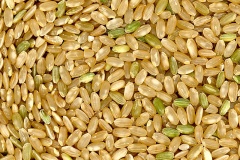Rice (incl. transport guidelines)
From Cargo Handbook - the world's largest cargo transport guidelines website
| Infobox on Rice (incl. transport guidelines) | |
|---|---|
| Example of Rice (incl. transport guidelines) |  |
| Facts | |
| Origin | This table shows only a selection of the most important countries of origin and should not be thought of as exhaustive.
|
| Stowage factor (in m3/t) |
|
| Angle of repose | - |
| Humidity / moisture |
|
| Oil content | - |
| Ventilation | Loading as bulk cargo: surface ventilation. Loading as general cargo: air exchange rate 15 - 25 changes/hour. Good surface ventilation and airing are necessary. |
| Risk factors | At an excessively high water content in particular, rice has a tendency towards self-heating. Water contents of > 15% and relative humidities of > 75% result in self-heating of the cargo due to hydrolytic/enzymatic fat cleavage. Rice is highly odor-sensitive, prone to contamination and shrinkage. Beware of infestation. |











